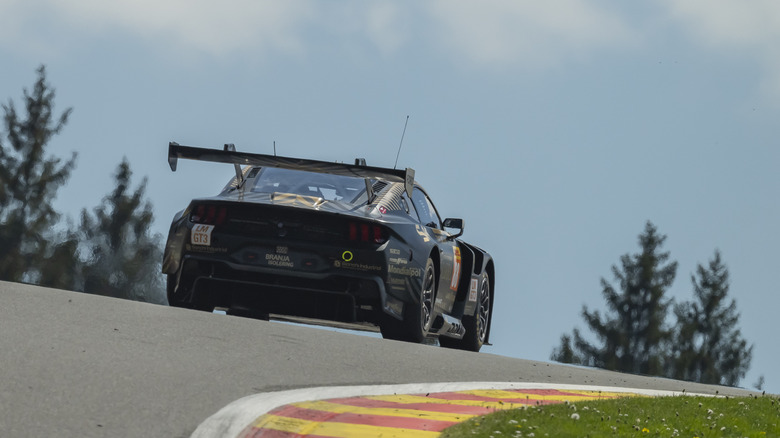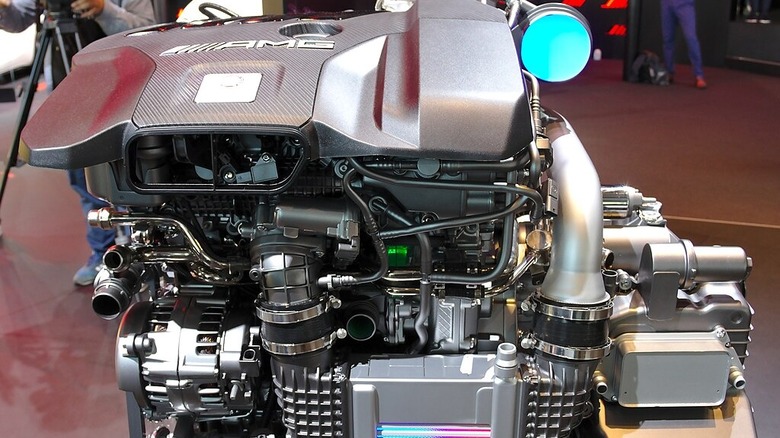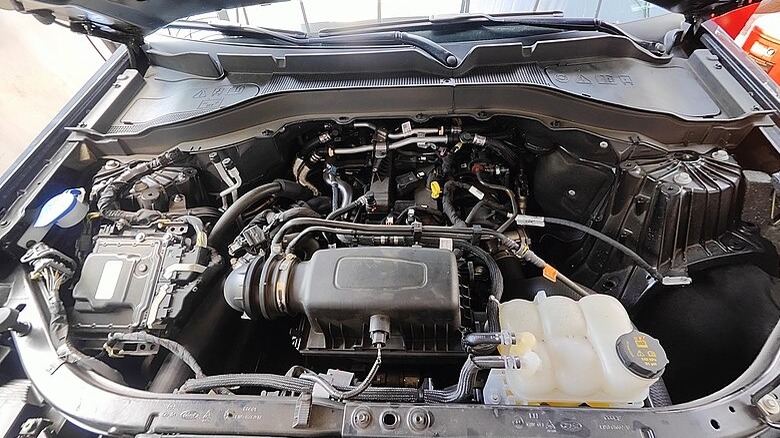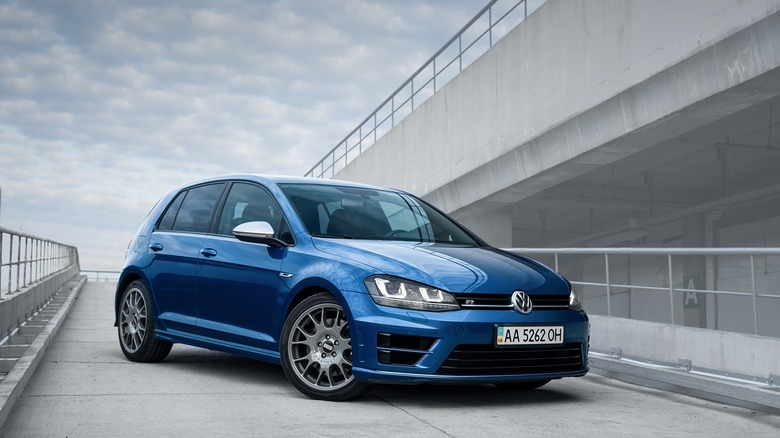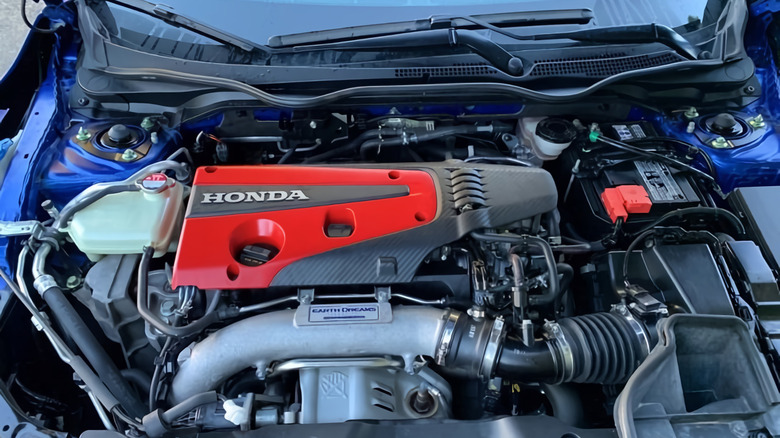5 Of The Most Powerful Inline-4 Engines Ever Put In A Car
Inline-4 engines have been a popular choice for both consumers and manufacturers for a long time, as far back as the '60s. This is especially true because these engines have built a reputation for balancing efficiency, power, and eco-friendliness over the years.
One of the biggest reasons why fans and manufacturers like inline-4 engines is their ability to provide impressive power outputs without the added complexity and weight of larger engines. In fact, considering the tech improvements along the way, power figures of some inline engines today are even comparable to larger V6 and V8 engines. Think turbocharging, direct fuel injection, and variable valve timing — all meant to improve the performance potential of inline-4 engines. You will even find some of these engines to be the most reliable turbocharged engines ever built. Because of this balancing act, you'll find inline-4 in a very wide range of vehicle types, too, from economical compacts to high-performance sports cars.
Now that we've established inline-4 engines are powerful, which engines are the most powerful? That's what we are going to find out.
Mercedes-AMG M139 (model S)
The Mercedes-AMG M139 engine is an obvious choice for this list, since it's often regarded as the most powerful turbo four-cylinder engine in the world. Introduced in 2019, the M139 is built at AMG's Affalterbach plant using a process in which each engine is hand-assembled under the "One Man, One Engine" philosophy, and it's exactly what it sounds like. Having just a single engineer complete an engine is a technique that even some JDM engine manufacturers like Mazda use for precision and quality.
The M139 comes in two versions: the base configuration creates up to 382 horsepower, while the S model produces a powerful 416–421 horsepower. The S model engine's peak torque is at 369 lb-ft. The engine also redlines at 7200-rpm — leaving no doubt that this is an absolutely potent engine. Another impressive feat by the M139 is the fact that it comes up with such a power output for a displacement of only 2.0 liters. The construction of the engine itself is built using a chill-cast aluminum block and a twin-scroll turbocharger with roller bearings to reduce mechanical friction.
With these specs, it's hardly surprising that it powers a variety of Mercedes' high-performance cars, including the Mercedes-AMG A45, CLA45, and GLA45, and was most recently fitted in the Mercedes-AMG GT 43 Coupe. This shift toward smaller, more efficient engines that still produce significant power, balancing performance, fuel efficiency, and environmental concerns is a welcome one for us as consumers.
[Featured image by Alexander Migl via Wikimedia Commons | Cropped and scaled | CC BY-SA 4.0]
Ford EcoBoost 2.3
Ford's EcoBoost is a super reliable inline-4 engine that owners swear by, but it's also great when it comes to power and performance. This turbocharged powertrain, debuted in 2015, really set a bar for performance at the time for an engine with great depth in Fords it powered. There are many things that make Ford's EcoBoost engines so special, so let's get to it one by one.
The engine produced 285 horsepower and 305 lb-ft of torque — well above average. But as it evolved, it found its way into a range of Ford cars, including the Mustang, Explorer, and the performance-oriented Ford Focus RS, where it could create up to 350 horsepower and 350 lb-ft of torque! What set the 2.3-liter EcoBoost apart is its use of features like turbocharging, direct fuel injection, and twin independent variable camshaft timing, which not only increase power but also improve fuel efficiency and lower emissions. This is where the "EcoBoost" part came from — significant power without the size and fuel consumption of larger engines.
When it comes to applications, the 2.3-liter EcoBoost is clearly versatile — it powered many Fords, from the tough Bronco and the elegant Mustang. Notably, in the Mustang, it produces 310 horsepower and 320 lb-ft of torque, which can hold a candle to the output of earlier, larger V8 engines. You can also find this engine in other high-performance vehicles, like the Dallara Stradale, which uses a version with 395 horsepower.
[Featured image by Iamjosemon via Wikimedia Commons | Cropped and scaled | CC BY-SA 4.0]
Mitsubishi 4B11T
The Mitsubishi 4G63T is a special JDM engine, for sure, but when it comes to the most powerful inline-4 engines, the 4B11T might have a slight edge. In fact, this engine was introduced in 2007 as the replacement for the more famous 4G63. It was produced until 2015, and was designed largely for later versions Mitsubishi Lancer Evolution series, like the Evo X. When it comes to the build, this engine has an all-aluminum construction, doing away with the cast-iron blocks of its predecessors, and not just reducing weight but also improving thermal efficiency.
But it's power that we are interested in and the 4B11T powered a variety of high-performance models, producing outputs anywhere from 240 to a potent 440 horsepower, as well as torque values ranging from 260 to 412 lb-ft. It's the top-tier Lancer Evolution X FQ440, one of the most powerful variants, that really pushed the engine to its extremes, producing 440 horsepower. The engine's design had a lot to do with this power. Its square shape, with an 86 mm bore and stroke, allowed for free-revving and power output across a wide rpm range. Mitsubishi's MIVEC technology enabled variable valve timing on both the intake and exhaust camshafts, also improving performance and efficiency.
Despite being discontinued in 2017, the 4B11T is still a popular choice for modders and tuners. With the right mods, we might be looking at horsepower values that are much higher than the factory settings.
Volkswagen EA888
Since its introduction in 2004, the Volkswagen EA888 engine has become a standard in various VWs, SEATs, and Audis — with good reason. This is an engine that really evolved over time, progressing through three generations, each of which introduced significant advancements. Since we are looking for the most powerful inline-4s, we'll have to look at the most prominent variation, the EA888 Evo 4. This variant debuted in 2021 has the numbers to show for its performance. It has a displacement of 1,984cc and generates power ranging from 316 to 329 horsepower with torque of 310 lb-ft. It's notably featured in the high-performance Volkswagen Golf R Mk VIII, as well as the limited-production 20th Anniversary Edition. The EA888 has tremendous tuning possibilities, too.
Despite giving out that many horses, the EA888 was designed to reduce emissions and increase fuel efficiency. It features a dual overhead camshaft (DOHC) and both multiport and direct fuel injection systems. The engine's lightweight construction — which includes a cast-iron block and an aluminum alloy cylinder head — means that it does not overburden the vehicles it drives. Light weight, but also sturdy. The EA888s have been reported to last longer than 250,000 miles when properly maintained. In fact, the build is one part of what makes the Volkswagen EA888 one of VW's most reliable engines ever made, and so you'll find this engine in everything from the fast Golf GTI and elegant Audi A3 to the rugged Tiguan and beyond.
Honda K20C1
The Honda K20C1 2.0-liter inline-4 engine, introduced in 2015, is the most powerful type in Honda's K-series portfolio since the series' introduction in 2001. You'll find the K20C1 featured in cars like the Honda Civic Type R and the Acura Integra Type S — one of the fastest Acura models ever made, by the way. And this is thanks to the impressive 320 horsepower and 310 lb-ft of torque that the engine produces. This turbocharged powerhouse is a big part of why the Civic Type R's is one of the fastest front-wheel-drive cars, having set records at the Nürburgring. Its turbocharger generates 23 pounds of pressure as well.
The engine has a displacement of 1,996cc and a fuel-efficient gasoline arrangement. It uses "reverse" V-TEC technology, which is different from its normally aspirated predecessors and optimizes performance solely on the exhaust camshaft. This kind of unique setup enables the engine to generate a consistent power band while remaining very efficient. Besides this design, the K20C1 is manufactured with a lightweight crankshaft, stronger piston rods, and a revised cylinder head.
Another reason that makes the K20C1 powerful is its tuning potential. The engine might even be a good candidate for aftermarket mods, and really boost its already impressive power figures. That being said, its status as a high-demand engine means it is relatively expensive and harder to find for extensive tuning projects.
[Featured image by Midship Runabout via Wikimedia Commons | Cropped and scaled | CC BY-SA 4.0]
